 Your new post is loading...
 Your new post is loading...
As President Donald Trump wages daily war against the press, millennials are subscribing to legacy news publications in record numbers—and at a growth rate, data suggests, far outpacing any other age group.
Since November's election, the New Yorker, for instance, has seen its number of new millennial subscribers more than double from over the same period a year earlier. According to the magazine's figures, it has 106 percent more new subscribers in the 18-34 age range and 129 percent more from 25-34.
The Atlantic has a similar story: since the election, its number of new subscribers aged 18-24 jumped 130 percent for print and digital subscriptions combined over the same period a year earlier, while 18-44 went up 70 percent.
Newspapers like The Washington Post and The New York Times typically do not share specific subscriber data, but according to a Post spokesperson, its subscriber growth rate is highest among millennials. A New York Times representative relayed that the paper was “seeing similar trends” in subscriptions and pointed to public data on digital traffic that showed its online reach among millennials to be up 9 percent from the same period a year ago.
Embattled publishers got some good news: Amazon’s launch of a new service selling online subscriptions, including digital magazines and newspapers, gives publishers access to its vast online retail customer base as a potential audience.
The new marketplace, “Subscribe with Amazon,” allows the subscription seller to create a customized detail page with product images, offering digital subscriptions, with the option for tiered pricing schemes where necessary.
The seller can also offer inducements, including free trials or introductory prices. Under the terms offered at launch, subscription sellers receive 70% of the sales revenue for the subscriber’s first year, rising to 85% for each subsequent year.
To paraphrase Oscar Wilde: “The only thing worse than transitioning from a print to digital advertising model, is not transitioning from a print to digital advertising model.”
OK -- Oscar’s version was a lot pithier. But the paradox pretty well sums up the predicament faced by newspaper publishers, who not only must contend with declining print circulation and ad woes, but also face disappointing returns on the digital ad side, per the Pew Research State of the News Media Report.
According to Pew, U.S. newspaper publishers’ total advertising revenue sank 8% in 2015 compared to the prior year, with most of this decline due to continuing drops in print ads, which still make up 75% of total ad revenues, and fell 10% last year.
However, digital, long touted by publishers as the future of the industry, isn’t even close to making up for these drops: Digital advertising actually sank by 2% as well.
(Pew’s estimates for ad revenue are based on its analysis of results from seven large, publicly-traded newspaper publishers; Pew notes that the Newspaper Association of America stopped reporting official revenue figures for the industry back in 2013)....
A lot of people were surprised when Amazon CEO Jeff Bezos bought The Washington Post for $250 million in 2013.
At the time, The Post was a legacy media company facing years of decline, while Bezos had no prior experience in the newspaper business.
But in less than three years, Bezos has completely changed the outlook of the 140-year-old newspaper. Its readership has exploded, and its content has become more suitable for the digital world.
Here's a look back at how Bezos revitalized The Washington Post since taking over less than three years ago....
Student editor's response: "I’m so scared and excited I could pee my pants."
Medium now has Substance. The popular publishing platform recently started hosting Substance, a new student publication at Mt. San Antonio College that doubles as a totally reinvented version of The Mountaineer campus newspaper.
It is the first college media outlet to operate primarily on Medium. Substance adviser and MSAC j-prof extraordinaire Toni Albertson describes the arrangement as nothing less than “the perfect merge of tech and college journalism.”
In a bravura announcement yesterday about the merger, Albertson explained that the impetus behind it was two-fold — mounting staff frustration at the print production routine and growing reader ennui toward the print edition....
The Independent has unveiled a unique app based on reader feedback that combines the best of newspaper design with digital interactivity, making the most of tablets or smartphone technologytechnology
... Christian Broughton, Digital Editor at The Independent, said: “Most apps make do with a fairly static main edition. If they offer rolling news, it’s usually hidden away in a separate area. We’ve built breaking news into the very core of The Independent app. Our readers want and deserve breaking news, and they want multimedia too. But they also tell us that they like the feel and texture of a newspaper – nothing is simpler than flipping through pages. In geek-speak, that’s the ultimate intuitive UX! This app gives readers the best of both worlds.”
The question that still remains is why: Why would a technology entrepreneur invest in a stodgy media outlet in a declining industry? Was the motive for the move sentimental altruism or profit?
I think Henry Blodget at Business Insider hit the nail on the head in his piece when he said that:"Content and commerce companies have long dabbled with combining the two experiences, but no one has really nailed it. Given Amazon’s expertise in affiliate marketing and advertising, it’s not hard to imagine that the Washington Post could quickly become a laboratory for the next generation of integrated content and commerce."...
Does this strike you as strange? Everything I read and hear keeps telling me that newspapers are a dying industry. Circulation is way, way down. Everyone's getting information online nowadays. No one (besides me) reads newspapers any more.
So why, in the face of all this negative opinion about print media, would one of the world's most well-known and admired investors invest money in print media? I've never met Warren Buffett or had the opportunity to interview him for this column. I'm not privy to the details of this deal. And for all I know there may be a treasure chest of gold buried underneath the offices of the Press of Atlantic City.
But assuming that's not the case, I can think of a few good reasons why he would do this--reasons that have little to do with the newspaper business, but have a lot to do with business in general....
In pivoting aggressively from print to local TV, Gannett Inc. and Tribune Co. are embracing a legacy media model that could be headed for the same audience fragmentation and economic dislocation as the newspaper businesses they are trying to escape.
As detailed here yesterday, the two iconic publishing brands have announced parallel, billion-plus acquisitions that will boost their local broadcast holdings at the same time they reduce their exposure to the fraying newspaper empires on which both companies were built. Going further, Tribune is seeking buyers for some or all of a publishing portfolio that includes such prominent brands as the Chicago Tribune and the Los Angeles Times.
The long-time newspaper publishers can’t be blamed for being attracted to broadcasting. Television generated a record $49.7 billion in local and national advertising sales in 2012, while newspaper advertising revenues – which have been sliding relentlessly for seven years – ended 2012 at less than half the all-time high of $49.4 billion hit in 2005.
Though the transactions planned by Gannett and Tribune clearly reflect their confidence in the continued health of broadcasting, a look at the collapse of the once-indomitable newspaper business suggests that TV, in due course, could suffer a similar fate. We’ll review the accumulating evidence in a moment. First, here is a quick review of what happened to newspapers:...
Ben Huh, CEO of online humor destination, Cheezburger, offers his take on why Gene Weingarten’s recent column was wrong about journalism. Journalism still has much to learn about timeliness when an oft-awarded columnist like Gene Weingarten is 34 days late to a story. Journalism still has much to learn about reporting when the writer of the story was actually never present at the event. Journalism still has much to learn about the audience it supposedly serves when it continues to ignore the wants of its readership. It pains me to watch how much obstructionism blocks the progress of some well-meaning journalists, regardless of the humorous nature of Gene’s column....
|
Following last year’s presidential election, some major U.S. newspapers reported a sharp jump in digital subscriptions, giving a boost to their overall circulation totals. The newspaper industry as a whole, however, faced ongoing challenges in 2016, according to new Pew Research Center analysis. Yearly financial statements show that The New York Times added more than 500,000 digital subscriptions in 2016 – a 47% year-over-year rise. The Wall Street Journal added more than 150,000 digital subscriptions, a 23% rise, according to audited statements produced by Dow Jones. And the Chicago Tribune added about 100,000 in weekday digital circulation, a 76% year-over-year gain, according to its filings with the Alliance for Audited Media (AAM), an organization that verifies many daily newspapers’ circulation figures. But these gains did not translate into circulation growth for the industry overall. A Pew Research Center analysis of data from AAM shows that total weekday circulation for U.S. daily newspapers – both print and digital – fell 8% in 2016, marking the 28th consecutive year of declines. (Sunday circulation also fell 8%.) The overall decline includes a 10% decrease in weekday print circulation (9% for Sundays) and a 1% decline in weekday digital circulation (1% rise for Sundays). Total weekday circulation for U.S. daily newspapers fell to 35 million, while total Sunday circulation declined to 38 million – the lowest levels since 1945. (For more information on how these totals were calculated, see our fact sheet.)...
What if, in the mad dash two decades ago to repurpose and extend editorial content onto the Web, editors and publishers made a colossal business blunder that wasted hundreds of millions of dollars? What if the industry should have stuck with its strengths—the print editions where the vast majority of their readers still reside and where the overwhelming majority of advertising and subscription revenue come from—instead of chasing the online chimera? That’s the contrarian conclusion I drew from a new paper written by H. Iris Chyi and Ori Tenenboim of the University of Texas and published this summer in Journalism Practice. Buttressed by copious mounds of data and a rigorous, sustained argument, the paper cracks open the watchworks of the newspaper industry to make a convincing case that the tech-heavy Web strategy pursued by most papers has been a bust. The key to the newspaper future might reside in its past and not in smartphones, iPads and VR. “Digital first,” the authors claim, has been a losing proposition for most newspapers....
As of March, there were 197,800 Americans working in the “internet publishing and broadcasting” sector versus 183,200 people working for U.S. newspapers.
The BLS data goes back to 1990, and since then employment at newspapers has fallen by nearly 60 percent, having peaked in June 1990 at 457,800 people. The number of newspaper jobs has fallen consistently since then.
Digital publishing, meanwhile, has grown considerably. Throughout much of the early 1990s there were around 30,000 online publishing jobs, though that figure grew to 112,000 by 2000. Then the dot-com bubble burst and the number of jobs shrunk by about half....
So these young men and women, who are highly savvy when it comes to new media, and how to spread news using it, had no idea that you can buy space for a personal announcement in a print product and its online equivalents.
I suspected that they'd see me as a media dinosaur for feeling it was important to mark such an important life event in print. But they didn't. In fact, they all thought it was really cool.
So Bea hung fire on the Facebook update until The Times announcement was published, and then did a screen grab from The Times iPad app that became her Facebook post. Then she bought five copies of the paper.
Of course, many more people saw that Facebook announcement than heard of the engagement from The Times.
But I learned that it really mattered to these new-media natives that the first announcement came in the paper-of-record environment of the Times....
For a moment, let’s not focus on the delicious irony of Buzzfeed breaking the second biggest news about The New York Times this week. The site -- which many a Times staffer probably sniffs derisively at -- uploaded the paper-of-record’s entire 91-page “Innovation Report” that calls for de-emphasizing print in favor of a more sophisticated approach to digital. If you’re in digital, it’s even more intriguing than the news on Wednesday that executive editor Jill Abramson had been unceremoniously shown the door.
More than anything else, the report points to the Times’lackluster, scattershot approach to digital innovation, particularly in audience development, an imperative when so much content and readership comes from the act of sharing. In one of its many trenchant-but-obvious observations, it points out that “our digital content needs to travel on the backs of readers to find new readers.”...
In October 2012, just 23 percent of Americans told Pew they read even one newspaper the previous day. So who in the world could possibly want or need unlimited access to 2,500 of them?
Alex Gruntsev, EVP and chief innovation officer of PressReader, made a compelling case in a phone interview that his “Netflix-style” subscription service — $29.95 per month — fills a niche in online news publishing by presenting news in a form that many automated aggregators cannot.
PressReader, formerly NewspaperDirect, has long provided PDF replicas mainly as a specialty business, but now it’s focusing on a wider consumer audience. “For just your morning routine, to open a PC was difficult,” Gruntsev said. “But in 2010, with the first iPad, the experience of reading dramatically changed, and it became way more appealing to the average reader.”
Now, PressReader users online or on tablets don’t just get static images of newspaper pages; they can jump into individual stories by clicking headlines. That launches PressReader’s SmartFlow mode, which allows for a seamless stream of stories scrolling left to right....
The New York Times Company did the world of journalism a big favor today.The company finally disclosed the exact revenues of its digital business.The numbers were impressive. And they made clear that no one ever needs to fret about the future of journalism again.Specifically, the New York Times reported that the revenue of its digital business is now about $360 million a year....
... It was an industry-wide response, and readers noticed, Brusic said. "Imagine it's your daily coffee. Each time you put down your money the cup gets smaller and the brew gets weaker. That's essentially what's happened to American newspapers. We took things away from people and at the same time gave content away free on the web. How crazy is that? The industry committed a kind of institutional suicide over time."Some, like the Rocky Mountain News, closed. Others, like the San Francisco Chronicle, limped on, feeble, malnourished versions of former selves....
The digital circulation growth shown in the latest figures from the Audit Bureau of Circulations is helping to ease a relentless overall decline in recent years.
Been having some interesting discussions with social media marketing/techdev types the past few weeks and I've come to realize that the SM industry is about as inbred as an industry can get. That's not good. Here's the background: I am still very tied into the old media world through very deep relationships. I have good friends that not only work for newspapers, they own them. 5 years ago these friends saw they businesses crumbling but they still thought there was a chance to turn it around and the SM was just a fad. Today it is quite different. They understand they were wrong now, but they still don't understand how to put it into the context of their audience... because the SM industry doesn't care about context. They care about selling stuff... through relationships. In other words, an industry built on Amway marketing philosophy....
|
 Your new post is loading...
Your new post is loading...
 Your new post is loading...
Your new post is loading...






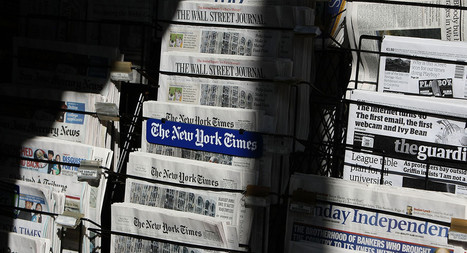

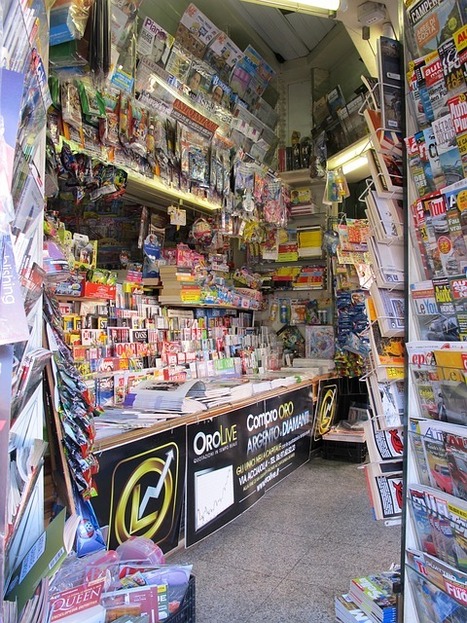







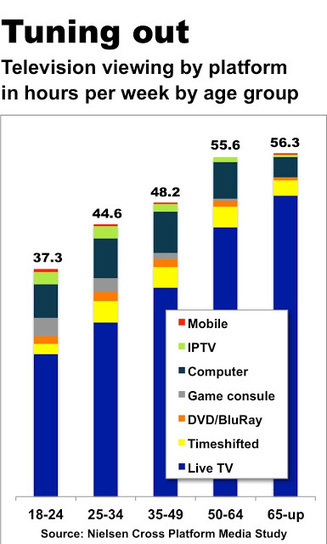

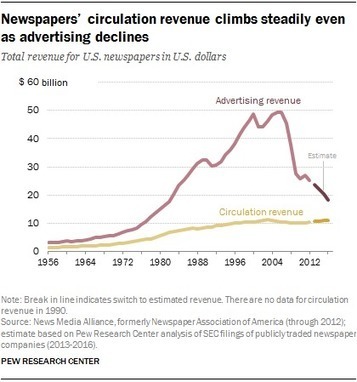


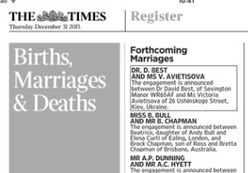

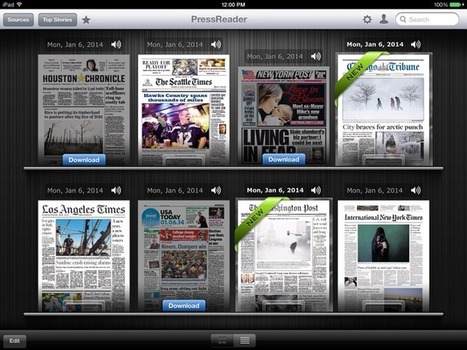

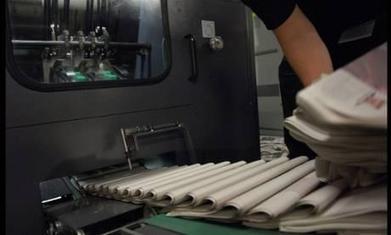







Newspaper subscriptions growing again? By millennials? You betcha.